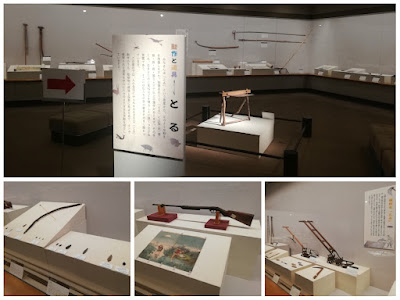Feature Exhibition Room 4
August 17th (Wed.) ~ October 23rd (Sun.), 2022
 |
Painting depicts people catching tunas |
The Japanese word “toru” has many different
Kanji characters and different meanings, but the pronunciation remains the
same. A dictionary search of "toru" reveals more than 30 kanji
characters, including 取, 把, 捕, 執, 採, 摂, 撮, among others. These mainly mean
"take," "get," "obtain," "pick up,"
"catch," "manage," "gather," or
"ingest," as well as other related meanings. Many of these words are
deeply connected to obtaining food and other items to live and the movement of
our hands is a big part of that action.
For example, the method of “hunting” or
“catching” (toru, 捕る, 獲る) an
animal for human consumption began with or “throwing” (nageru, 投げる) stones at the beast and “hitting” (ateru, あてる) it. The throwing of stones eventually led to the creation of more
effective weapons like stone spears that were thrown using the entire body.
Later, in order to efficiently kill fast-moving animals, the action of
“shooting” (hanatsu, 放つ) arrows was added to the action
of throwing. In the Edo period (1603-1867), when hunting rifles became more
popular, it became possible to hunt a larger variety of prey at greater
distances. The action of drawing the bow with the whole body and releasing the
arrow was transformed into the action of “pulling” (hiku, 引く) the trigger with the fingers.
Among the various “toru” activities seen in
daily life, this exhibition focuses on capturing or hunting animals and
gathering plants, and introduces various human activities, with a focus on the
tools used in them.
 |
| Exhibition view |

0 件のコメント:
コメントを投稿